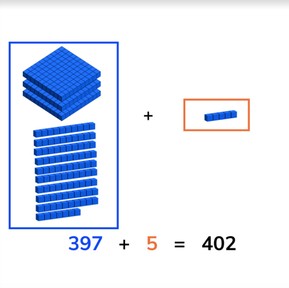
Addition to 1,000 with crossing tens and hundreds
Students learn to add numbers to 1,000 crossing tens and hundreds.



8,000 schools use Gynzy
92,000 teachers use Gynzy
1,600,000 students use Gynzy
General
Students learn to add numbers to 1,000 crossing tens and hundreds.
Common core standard(s)
2.NBT.B.7
Relevance
Discuss with students that it is important to be able to add numbers to 1,000 crossing tens and hundreds so you can determine total quantities.
Introduction
Show a few math problems on the interactive whiteboard and ask students to determine which student has the correct answer. Have them explain their thinking.
Development
Explain to students that you can add numbers by counting quantities. You start by counting how many you already have, this is the first addend in the addition problem. Then count how many are being added, and that is the second addend in your addition problem. When you count the two together, you find your total. Show this on the interactive whiteboard using the blocks and showing different addition problems. Check that students are able to add by having them demonstrate with the blocks and dollars. Next explain to students that you can add in different ways. You can use a number line to add the numbers together. You can also split the second addend and break it up into smaller numbers that you add to the first addend. You break the second addend into hundreds, tens, and ones, and add those to the first addend in steps. You can also split both the first and second addends and add the hundreds together, the tens, the ones and add those three totals together. Have students solve a few math problems individually and then ask them to explain their strategy. Finally show students how to solve a story problem. They must first determine what kind of math problem is in the story, then to determine which numbers are important to the math problem. They next say or write the math problem, and finish by solving the math problem. Do one story problem as a class and then have students solve a story problem individually or in pairs.
Check that students are able to add numbers to 1,000 crossing tens and hundreds by asking the following questions:
- Why is it useful to be able to add numbers to 1,000?
- Which methods can you use to add the numbers in an addition problem?
Guided practice
Students are given addition problems with visual support, without visual support, and in story form.
Closing
Discuss with students that it is important to be able to add numbers to 1,000 crossing tens and hundreds, so you are able to determine the total quantity you have. Show the money on the interactive whiteboard and ask which math problem represents the money shown. Then show a problem for students to solve and discuss their answers. Next solve a story problem as a class. Make sure to discuss the steps of a story problem. Have each students write a number between 1 and 500 on a sheet of paper. Have them form pairs and then solve the addition problem that coms from adding their two numbers together.
Teaching tips
Students who have difficulty with this learning goal can be supported by making use of manipulatives like MAB blocks or a number line. Remind them that they can make jumps of any size on the number line. Start by having students practice adding numbers that cross tens, then those that cross hundreds. By starting with easier problems like 294 + 9 and increasing the difficulty, you build their confidence.
Instruction materials
Paper
Optional: MAB blocks or other manipulatives
The online teaching platform for interactive whiteboards and displays in schools
Save time building lessons
Manage the classroom more efficiently
Increase student engagement
Discover more!
About Gynzy
Gynzy is an online teaching platform for interactive whiteboards and displays in schools.
With a focus on elementary education, Gynzy’s Whiteboard, digital tools, and activities make it easy for teachers to save time building lessons, increase student engagement, and make classroom management more efficient.



